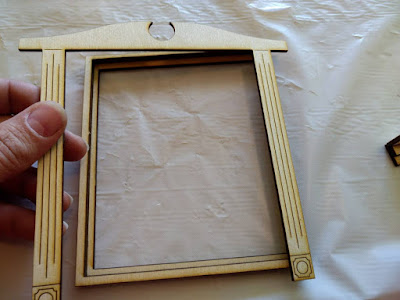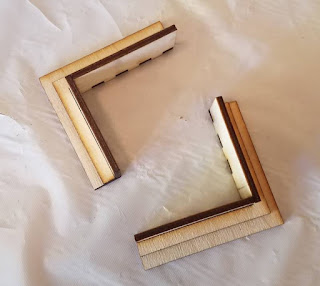THIS POST HAS BEEN SUPERSEDED HERE: New Door Assembly Instructions
The instructions below are for an earlier version of the door assembly and should only be used for those older door kits that would have been received prior to August 2020.
These following steps show you how to assemble the Door.
THE DOOR KIT:
This is how we start the door, all packaged up and ready to assemble.
Contents include a front frame, a back frame, a back block, a face, 2 door panels, 2 door panel backs, 12 raised panel pieces, 4 hinge pins and a pack of 2 door handles.
DRYFIT ORIENTATION:
FIRST THINGS FIRST: (2 VERY important steps)
FIRST, make sure you have the 2 frame pieces orientated with the smaller (narrower/thinner) part/edge AT THE TOP. The thicker part of the frame goes on the bottom of the door.
SECONDLY: Make the distinction of the Front Frame (with hinge holes) and the Back Frame (with NO hinge holes). Obviously, the Front Frame (with hinge holes) will be on the front and will be where the door panels hinge on the frame. The 'back' frame goes between the front frame and the back block (which is the thicker edged frame piece)
Now you may notice there is a 'front side' and a 'back' side of each of these pieces (the backs of the pieces have some minor darkening around the cut areas. (Keep in mind these parts are precision laser cut).
Align the two 'back sides' of the two frame parts for gluing.
DOOR FRAME ASSEMBLY:
Using the Gluing Jigs (shown above and described here), we'll now press the two opposite corners of the door frames and glue them up. Using the jigs ensures that the two frames are properly aligned. We have designed most of our kit with pretty tight tolerances so keeping things aligned is paramount.
In the image above, you can see the Gluing Jigs on opposite corners. Gentle Pressure towards each other will ensure the frames align properly. (Be sure to not push too hard or you may skew the frames)
Now add glue to one of the frames, set on top of other, use the gluing jig to align, then apply pressure to glue to the two frames together.
And you get the following:
Make note of the Hinge Hole location because it will be VERY IMPORTANT on this next step!
ADD BACK BLOCK:
We now align the back block withe now-glued frame.
NOTE THE ALIGNMENT!
The Front Frame (with the hinge hole) is on TOP, then the Back Frame (no hinge hole), THEN the Back Block (fatter edges).
Place the Back Block on the table with the 'Good/front face' UP! This will provide a bit better gluing surface for later on. So if you can tell the difference on the front face and the back face, place the back face DOWN.
Add glue to the back of the back frame (non hinge piece).
Use the Gluing Jig to hold the corners and apply pressure to glue well.
Your door frame should now look like this!
ADD DOOR FACE/TRIM:
Now we add the Face/Trim to the door. Place the 'now-glued-up' frame with the Back Block DOWN on the table. (this places the Front Frame (with the hinge hole) on TOP)
Align Door Face with front of frame.
Make ABSOLUTELY SURE that the top two inside corners of the door face/trim align with the inside corners of the frame.
Add glue and apply pressure to finish assembly.
Here is your door frame complete! Make note of the location of the individual parts.
You can now add a little extra CA glue to the backside of the seams if you'd like a little more security.
Now we add the Face/Trim to the door. Place the 'now-glued-up' frame with the Back Block DOWN on the table. (this places the Front Frame (with the hinge hole) on TOP)
Align Door Face with front of frame.
Make ABSOLUTELY SURE that the top two inside corners of the door face/trim align with the inside corners of the frame.
Add glue and apply pressure to finish assembly.
Here is your door frame complete! Make note of the location of the individual parts.
You can now add a little extra CA glue to the backside of the seams if you'd like a little more security.
NOTE:
#1 - The thinner panels (with line etching only) are the back panels, the thicker front panels (cut through) have a hinge hole.
#2 - The small squares both need to be at the top of the door.
#3 - There is a small bump on the hinge side. This little bump should align perfectly with both the front and back panels. This is how you verify you have the doors aligned correctly.
Most importantly, YES - the back panels are different widths than the front panels. This is designed so that light will not come through between the doors. When the panels are assembled, the right hand panel will open first (because the back panel of the left-side door will be behind the front panel of the right-side door)
Once aligned and you are sure the correct panels are in the correct place, you can then add glue to the back of the front panel, align with the back panel (while pressing both down on a hard surface to help align the side) and carefully press the two panels together.
Most importantly, please be sure these two panels are well aligned. In the event they aren't perfect, you can use an Exacto knife to trim off any overhang of the back panel.
Repeat on the other door panel (shown above)
The next step on the door panels is to round over the hinge side. This can easily be done with a simple piece of sandpaper, or you can carefully use a band sander - whatever your preference.
As shown in this image above, you want to round off that hinge edge just a bit so that those corners don't interfere with the frames while the doors are swinging.
Just note - it's easier to sand more off than to add wood back on, so sand slowly until it looks and works well in the frame.
RAISED PANELS:
Now we add the raised panels into the Frame cutouts. Do NOT use super thin CA glue here - you probably want to use a gap filling/thicker one.
Layout the small raised panel pieces on either side of the door, to align with the proper sized openings.
Add CA Glue to the openings (you can do them one at a time if you'd prefer).
Now drop the correctly sized raised panel into the correctly sized opening ** BUT Don't Push It Down Yet! **
Instead, use an Exacto knife to carefully move the raised panel a bit (the raised panel will 'float' a little on the thicker glue) until you have it where you want it (probably centered in the opening), then carefully apply pressure to the raised panel until it is well glued down. At this point - the raised panel piece should not be able to move at all. (so make sure you get it right the first time).
Then repeat for every opening, as shown above.
Do one more application of pressure over each piece just to be sure they are well secured.
And now the panels are assembled. And in this image above, you can also see how the back panels are different widths and allow them to 'nest' with the other door when closed.
After the door is assembled, it will be time to paint. But you may choose to paint all the windows with the door. If so, assemble all the windows first. You can learn more about assembling the windows.
Questions? Please feel free to contact us on our website!























































